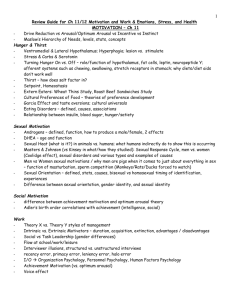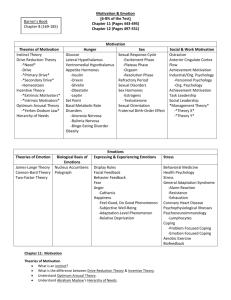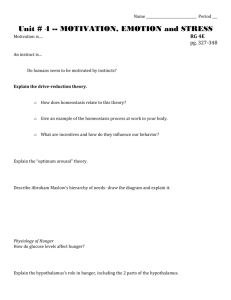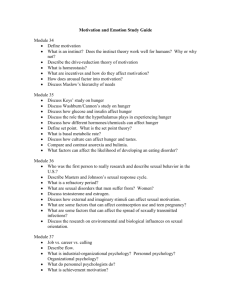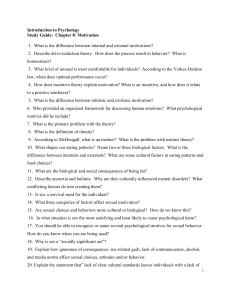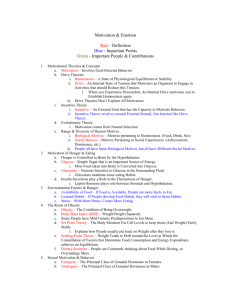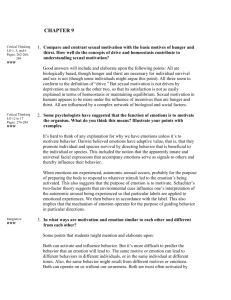Quiz 11/7/08 Eating Disorder
advertisement
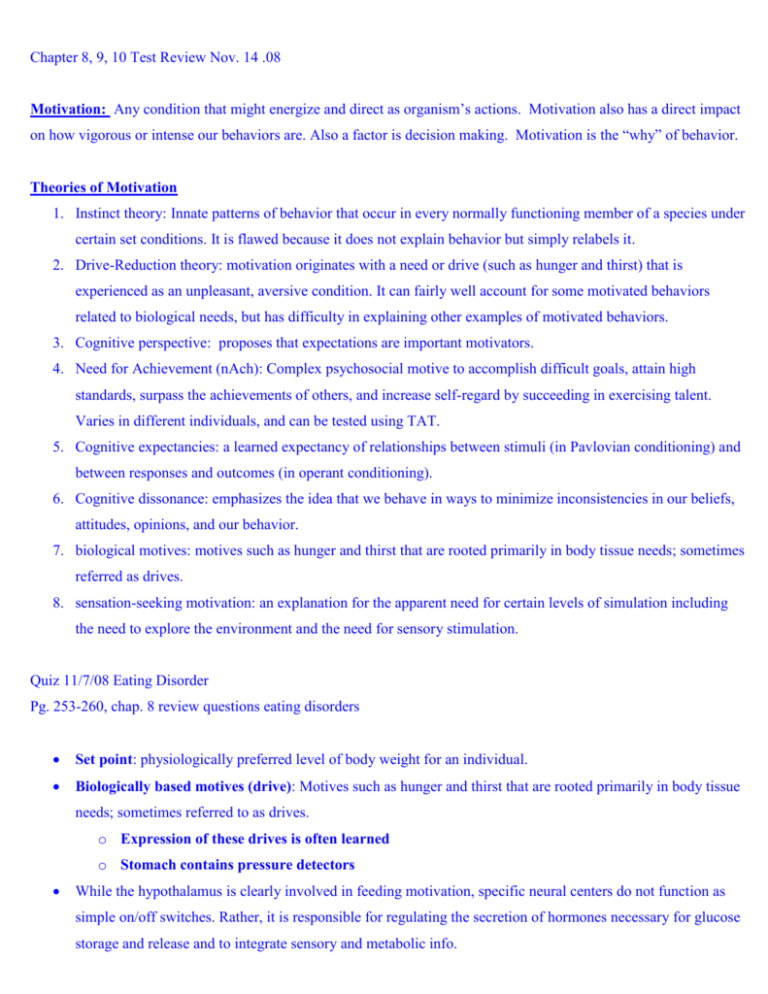
Chapter 8, 9, 10 Test Review Nov. 14 .08 Motivation: Any condition that might energize and direct as organism’s actions. Motivation also has a direct impact on how vigorous or intense our behaviors are. Also a factor is decision making. Motivation is the “why” of behavior. Theories of Motivation 1. Instinct theory: Innate patterns of behavior that occur in every normally functioning member of a species under certain set conditions. It is flawed because it does not explain behavior but simply relabels it. 2. Drive-Reduction theory: motivation originates with a need or drive (such as hunger and thirst) that is experienced as an unpleasant, aversive condition. It can fairly well account for some motivated behaviors related to biological needs, but has difficulty in explaining other examples of motivated behaviors. 3. Cognitive perspective: proposes that expectations are important motivators. 4. Need for Achievement (nAch): Complex psychosocial motive to accomplish difficult goals, attain high standards, surpass the achievements of others, and increase self-regard by succeeding in exercising talent. Varies in different individuals, and can be tested using TAT. 5. Cognitive expectancies: a learned expectancy of relationships between stimuli (in Pavlovian conditioning) and between responses and outcomes (in operant conditioning). 6. Cognitive dissonance: emphasizes the idea that we behave in ways to minimize inconsistencies in our beliefs, attitudes, opinions, and our behavior. 7. biological motives: motives such as hunger and thirst that are rooted primarily in body tissue needs; sometimes referred as drives. 8. sensation-seeking motivation: an explanation for the apparent need for certain levels of simulation including the need to explore the environment and the need for sensory stimulation. Quiz 11/7/08 Eating Disorder Pg. 253-260, chap. 8 review questions eating disorders Set point: physiologically preferred level of body weight for an individual. Biologically based motives (drive): Motives such as hunger and thirst that are rooted primarily in body tissue needs; sometimes referred to as drives. o Expression of these drives is often learned o Stomach contains pressure detectors While the hypothalamus is clearly involved in feeding motivation, specific neural centers do not function as simple on/off switches. Rather, it is responsible for regulating the secretion of hormones necessary for glucose storage and release and to integrate sensory and metabolic info. Ventromedial hypothalamus (VMH): “off switch” to stop eating--a region of the hypothalamus in which damage results in faster gastric emptying and an increase in insulin production. o Hyperghagia: extreme overeating and obesity-happens when the VMH is destroyed. Lateral hypothalamus (LH): “on switch” or feeding center--an area of the hypothalamus that is important for taste sensation, mediating digestive processes, and salivation. o When destroyed there is reduce in consumption of food or stop eating altogether…known as aghagia. Glucostatic hypothesis: theory that hunger results when glucorecptors detect a lack of glucose, either because blood levels of glucose are low of because insulin (secreted by the pancreas) is not available in sufficient quantity. Hormones controlling Hunger: o CCK –is released when food enters the duodenum; it then seems to travel through the bloodstream to the brain where it acts to inhibit eating behavior. An alternative mechanism for CCK action may be that it disrupts the sensory signals for taste, thereby, making food less palatable. o Neuropeptide Y- may be the most powerful stimulant to feeding. o Leptin-is secreted by fat cells and counters the effects of neuropeptide Y in the hypothalamus. Injections of leptin have shown to inhibit eating and increase metabolic rate. Obese: condition in which as individual weighs 20% or more above the desirable weigh for his/her height. o Over 65% are overweight and 30% of adult Americans are obese. o Increases the risk of high blood pressure, stroke, heart disease, diabetes, cancer, gall bladder disease, respiratory problems, and arthritis. o Studies linked obesity with body image and depression. o Theories of obesity Genetic causes Early childhood experience Metabolic factors-metabolic syndrome Reaction to emotional stress Anorexia: prolonged refusal to eat adequately amounts of food. Most common in young females…social influences, media, peers play a big role Bulimia: periodic episodes of binge eating followed by deliberate purging using either vomiting or laxatives. Optimum Level of Arousal Arousal: A physiological state in which an individual is able to process info effectively and to engage in motivated behavior. A certain level of arousal is essential n order to express goal-directed behavior. But too much arousal may leave us over-stimulated, overloaded, and temporarily incapable of effective action. Optimum level of arousal: (Hebb) our performance on a task will improve as arousal increases up to an optimum level. Yerkes-Dodson Law: Principle that the optimum level of arousal for peak performance will vary somewhat depending on the nature of the task. Ex. If you’re involved in a simple task, you probably perform best if your arousal level is relatively high. Vice versa. It is now generally recognized that the Yerkes-Dodson law is somewhat oversimplifies the complex relationship between arousal and performance. Ideas about what is sexually arousing vary greatly across cultures of the world. Sexual conduct id regulated in some way in all societies, but the rules vary from one society to next. A high rate of sexual activity and extensive sexual instruction of youths is the norm on the Polynesian island of Mangaia. On the Irish island of Inis Bea, sexual expression is discouraged from infancy through old age. Sexual misinformation is common, and female orgasm is practically unknown. The Dani people of New Guinea demonstrate little interest in sexual activity and abstain from sex for years at a time. Sexual Motivation and Behavior Sexual interest and expression are controlled both by hormones, and more by the cerebral cortex, reflecting a combination of biological, psychological, and cultural factors. Biological bases of Sexual Behavior: Androgens: Male sex hormones, the most common of which is testosterone. About 95% of these are secreted by the testes in the form of testosterone; the other 5% are produced by the adrenal glands. MPA: a drug that reduces the amount of testosterone produced and has been used to treat sexual offenders. Anabolic steroids: males take for muscle building, which increase the level of sexual motivation. Estrogens: Hormones that influence female sexual development. The role of estrogens in far from clear. Psychosocial factors in Sexual Behavior It is likely that psychological and cultural conditions play a greater role in human sexual arousal and expression. Cultural mores: Established customs or beliefs in a particular culture. Sexual Orientation: sex to which an individual is attracted. Homosexual: primary erotic, psychological, and social interest in members of the same sex, even though that interest may not be expressed overtly. Theories of Homosexuality 1. Psychosocial theory: Learning, personal experiences, parenting patterns, or individual’s own psychological attributes. Ex. One explanation of homosexuality is that it may be a result of unhappy heterosexual relationships in the past. 2. Biological theory: genetic and hormonal factors contributing to brain development. “gay gene”—Research suggest that people may be biologically predisposed toward homosexuality either genetically or as a result of stress hormones during prenatal development. Chapter 9 Emotion and Stress Emotion: An individual’s subjective feelings and moods. The term applies to both physiological and behavioral responses to specific stimulus situations. Four Components of Emotion 1. Physiological arousal: emotions are associated with mild to extreme changes in the physiological processes occurring within our bodies. May also include- metabolic changes, altered muscle tension, changes in activity of the salivary and sweat glands, modified digestive processes, and changes in the levels of certain neurotransmitters in the brain. 2. Cognitive Processes: there is a general consensus that perception, learning, and memory are involved in emotions. For humans, cognitive processes are clearly involved in most emotional responses. 3. Behavioral Responses: often motivate us to act out or express our feelings. (ex. Freezing in fear, crying, screaming, smiling, laughing. Tone of voice, posture, other body language). Behavioral reactions of emotions may also serve to either promote or reduce the emotion (ex. Going out of your way to meet someone). 4. Feelings: can be described as a general positive or negative state such as joy, anger, fear, or disgust, but many feelings of emotion don’t easily fit these descriptions as well. The Range of Human Emotion Plutchik’s Emotional Wheel: there are 8 primary (basic) emotions, which consists of 4 pairs of opposites— acceptance and disgust, fear and anger, surprise and anticipation, and sadness and joy. Theories of Emotion 1. James-Lange Theory: proposes that bodily changes and behavioral reactions precede emotions. 2. Cannon-Bard Theory: Proposes that bodily changes, behavioral responses, and emotions occur simultaneously. 3. Schachter-Singer Theory: proposes that cognitive processes of interpreting both the emotion-causing event and bodily changes are central to the emotion experienced. 4. Tomkins’ Facial feedback theory: Proposes that knowledge of facial expression determines emotions. 5. Solomon and Corbit’s opponent-process theory: Proposes that following an emotional response the opposite emotional response occurs to restore emotional equilibrium. Darwin: according to him, each emotional “state of mind” was associated with a stereotyped set of reactions that were common within each species. He also believed that many human emotional expressions, particularly patterns of facial display, result from inherited traits that are universal in the human species. Darwin conducted the first recorded study of facial expressions of emotions. Stress: process of appraising events or situations as harmful, threatening or challenging, of assessing potential responses, and of responding to those events. Also, a pattern of physiology that accompanies threatening events.--study of stress has expanded to include emotional, cognitive, and behavioral changes as well as physical reactions. General Adaptation Syndrome (GAS): (Selye) Progressive responses to prolonged stress in which an organism mobilizes for action and compensates for stress. Repeated or prolonged exposure to stress that is not adequately managed or reduced results in tissue damage (bleeding ulcers), increased susceptibility to disease, and even death. Alarm, Resistance, and Exhaustion: prepare body for “fight or flight” Factors that Contribute to Stress Lack of control: the knowledge that something can be done may be sufficient to reduce the stress. Suddenness: ex. People in car accidents, death of loved one…It is easier to cope with challenges we can foresee. Ambiguity: a stressor that we see as ambiguous is likely to induce more stress than one that is clear-cut. Stress and disease: Coronary heart disease (CHD): any illness that causes a narrowing of the coronary arteries, the vessel that supply blood to the heart. May be a major contributor to CHD What kind of people are more likely to suffer from stress: Type A: workaholic—more prone to heart disease Type B: don’t care about work, slackers Type C: cancer prone individual, submissive, Hypertension: commonly referred as high blood pressure; a condition of excessive blood flow through the vessels that can result in both hardening and general deterioration of the walls of the vessels. -Angiotension is an important hormone involved in regulating fluid balance, and it is primary target for drugs used to control hypertension. Infectious disease: are caused by micro-organisms such as bacteria and viruses (colds, flu, and AIDS). Researchers have confirmed a strong correlation between stress and the onset and severity of infectious diseases. Stress responses impair the ability of your immune system to fight off infections. Cancer: a collection of many diseases, all of which result from genetic alterations in cells that produces runaway cell growth. Compelling evidence suggests a relationship between stress and cancer. Stress hormones weaken the immune system. Stress and Immune system: if the immune system is suppressed, we become more vulnerable to infectious organisms and cancers. Diasthesis model: stress Theories of emotion: fig 9.2 Stress: Psych : Exam nov 14 Emotion-affect 1. Object-perceived 2. Feelings-affect* 3. Facial: (Darwin wrote on expressions of man and animal); Tomkins4. physiological ≠ type => stress 5. Drives Chapter 10 Cognition: Thinking and Language Thinking: goes with remembering and beliefs; it implies a process of reasoning about a particular situation with the intent of solving a problem. Thought: any cognitive processes directed toward problem solving, understanding, memory retrieval, ad perceiving patterns in sensory inputs. -Thinking is the process that lets us make sense out of our perceptions. It allows us to put what we learn to use. It allows us to manipulate representations of objects, so that we can solve problems without going through any physical motions. Components of Thinking: Thinking as behavior: Watson believed that subvocal speech and overt motor action were essential for thinking, but study show that thinking can be independent of motor action. Skinner: Covert behavior- behavior that is unobservable in another person (thinking). Mental Images: may take form of visual, auditory, smell, or even tactile imagery. Concepts: mental categories for grouping events, objects, or processes. Most of our knowledge is in the form of concepts rather than independent, specific items or instances. Our ability to think and function efficiently would be greatly impaired if we were not able to form concepts. Association theory: Humans and animals learn concepts through association, other processes are involved. Examplar theory: the natural concepts we form in everyday life are structured around prototypes or typical representatives of categories (such as robins and jays as prototypes of the concept bird). Prototype: best or most typical representative of a category around which we often structure our concept of that category…the more closely objects or events match our prototypes for concept, the more we are likely to include them in a category. Problem Solving: Problems consists of 3 components 1. the original state of the situation as it exists at the moment, as perceived by the person 2. the goal state, which is what the problem solver would like the situation to be. 3. the rules or restrictions that govern the possible strategies for moving form the original state to the goal state. Stages of Problem Solving 1. representing the problem 2. generating possible solutions 3. evaluating the solution Strategies for problem solving 1. Trial and error: involves trying possible solutions, 1 by 1, to see which is correct. 2. Testing hypothesis: involves formulating specific hypotheses that generate relatively efficient approaches to solving a problem, then testing these hypotheses in a systematic fashion. 3. Algorithms: involves a systematic exploration of every possible solution; computers and people may use it to find the right answer. 4. Heuristics: rule-of-thumb problem solving strategies such as means-ends analysis and working backward. 5. Means-ends analysis: involves ID-ing the difference between an original state and a desired goal, then progressing through a series of subgoals to reach the solution. 6. Working backward: starts with describing the goal, then defines the step that directly precedes that goal, and works backward until the steps needed to reach the goal are defined. Cognitive influences on problem solving 1. Mental set: in problem solving, a tendency to approach a problem or situation in a predetermined way, regardless of the requirements of the specific problem. “think outside the box’ 2. Confirmation bias: the tendency to seek out evidence that confirms to overlook contradictory evidence. Reasoning and decision making 1. Inductive reasoning: reasoning that draws broad conclusions by generalizing from specific instances. 2. Deductive reasoning: begins with a general premise that is believed to be true, then draws conclusion about specific instances based on this premise. 3. Syllogisms: an argument consisting of 2 + presumably true statements, called premises, and a statement of conclusion that may or may not follow logically from the premises. Belief-bias effect: tendency to accept conclusions that conform to one’s beliefs (and reject conclusions that do not conform) regardless of how logical these conclusions are. Representative heuristic: strategy for categorizing an object or situation based on one’s preconceived notion of characteristics that are typically of that category. Availability heuristic: approach to decision making based on information assessed from memory. It assumes that the probability of an event is related to how frequently it occurred in the past, and that events occurring more frequently are easier to remembering. Framing: entails manipulating the reasoning process by increasing the representativeness and availability of an outcome. Language: is important to communicate, to reason, solve problems, remember…etc. Psycholinguistics: study of how sounds and symbols are translated to meaning… Phonemes: sounds that are the basic structural elements of language. Morphemes: the smallest unit of meaning in a given language. Syntax: set of language rules that govern how words can be combined to form meaningful phrases and sentences; grammar. Semantics: study of meaning in language. Theories of Language Acquisition 1. Learning perspective 2. Genetic perspective a. Language acquisition device (LAD): according to the genetic and nativist view, the prewiring that gives humans the innate ability to learn and understand language. Broca’s area: region of the left frontal lobe that is the primary brain center for controlling speech. Wernicke’s Area: the left temporal lobe that is the brain’s primary area for understanding speech.


